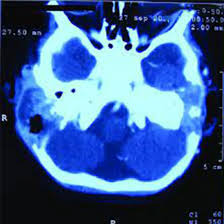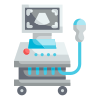Fill out form to enquire now
CECT Temporal Bone Axial and Coronal
Medintu has collaborated with the best pathology laboratories that are NABL and NABH certified and follow ISO safety guidelines to provide the best CECT For Temporal Bone Axial and Coronal at an affordable price for needy individuals. Contrast Enhanced Computed Tomography scan of the temporal bone is an enhanced imaging which is done in order to obtain highly detailed images of structures within and around ear, skull base and inner ear. This type of scan employs a contrast agent , usually an iodine based product , which is administered intravenous to improve the examination of the bones, tissues and other structures of the temporal bone.
Temporal bone is significant in hearing and balance tennis perplexing situated deep in the skull encompassing some significant construction such as cochlea, vestibular construction and the auditory construction. A CECT Temporal Bone scan in axial and coronal imaging can be far more effective in diagnosing neoplastic diseases, infection, injuries, congenital malformations, and degenerative changes. This single scan can provide both axial, or horizontal, images and coronal, or vertical, images that show the entire nature of the temporal bone and can help doctors generate accurate diagnoses and individualized treatment plans. To schedule an appointment for CECT For Temporal Bone Axial and Coronal, simply contact Medintu or call our customer care at +919100907036 or +919100907622 for more details and queries.
What is CECT Temporal Bone Imaging?
CECT Temporal Bone Imaging or Contrast Enhanced Computed Tomography Temporal Bone Imaging is a specific imaging modality employed for imaging the temporal bone and other related structures with high clarity and superb resolution using the latest CT equipments with addition of contrast media.
The temporal bone is sited at the bottom of the cranial cavity and has many functional features including housing the ear, auditory nerve, the cochlea and the middle ear bones. It is also essential for hearing or rather audiometry, and balance too. Considering this area to be rather complex and close to some essential structures, standard imaging tools could be insufficient. This is where CECT Temporal Bone Imaging comes in with improved picture quality and precision when diagnosing temporal bone related conditions.
How It Works:
- Contrast Material: While performing CECT scan, a special type of contrast dye, normally containing iodine, is introduced into the vascular system. This dye serves to improve the images so that it is easier to visualize the bone and soft tissue which are hardly distinguishable on a normal CT scan.
- CT Technology: CT scanner involves making of X-ray pictures of the head and neck from different directions. These images are then put together by a computer into cross sectional (axial) images and at times Three dimensions (3D) images thereby providing the doctor with a full view of the temporal bone’s structure and pathology.
- Axial and Coronal Views:
- Axial view (horizontal slices) offers clear representations of internal auditory canal, cochlea, vestible and mastoid aria cells in Fat to diagnose any fractures, tumors or infection in any of the structures of the inner ear.
- Axial perspective (horizontal sections) is employed to examine temporal bone position to substructural interface, including the middle ear, facial nerve and skull base; more comprehensive overview of disease states like cholesteatomas or assessment of outcome after surgery is provided by coronal view (vertical cross sections).
Axial vs. Coronal Views
During the CECT Temporal Bone Imaging scan, two scans that are very important are the axial and coronal scans as they give different information about the temporal bone and the structures in its region.
- Axial View
Definition: The axial view refers to a view that has a horizontal cut through the body to give the upper and lower sections. In the CECT Temporal Bone Imaging, it also provides axial sections which are the images taken along the ground.
What It Shows:
In the axial view, finer structures of internal auditory canal, cochlea, vestibular system and mastoid air cell structures are seen.
It is especially helpful for evaluating temporal bone pathology and its bony components including fractures, the state of the ear canal and the mastoid process.
Clinical Use:
In terms of images, the axial slice if ideal for any issues regarding the bones, such as fractures, or deformities in the temporal bone.
It gives some clarity of soft tissue to differentiate between simple chronic ear infections or cholesteatomas.
- Coronal View
Definition: The coronal sectioning is a partition of the body in the vertical manner separating the anterior and posterior halves. Furthermore, CECT imaging offers a more expansive panorama of the temporal bone in regards to the relation of the complex to the skull base and the facial nerve.
What It Shows:
Coronal plane section is best suited for viewing entire temporal bone and its topographic relation with the neighboring soft structures.
This technique enables viewing of middle ear, facial nerve, and mastoid area both in isolation and in relation to other structures which surround it.
Clinical Use:
The coronal view is used in conditions such as congenital malformation of the ear, tumor formation and to determine the severity of the injuries resulting from trauma or infections.
For the examination of pre- or post-surgical outcomes for such processes as middle ear surgery, or cochlear implantation, provides an overall coverage for pre-surgical planning.
Uses of CECT Temporal Bone Imaging
The CECT Temporal Bone Imaging can really be a valuable diagnostic study because it yields detailed image of Temporal Bone and other structures alongside Temporal Bone utilizing CE Ct and specific imaging planes. Below are the primary uses of CECT Temporal Bone Imaging:
- Diagnosis of Tumors
Acoustic Neuromas: The most prevalent tumor of the temporal bone is an acoustic neuroma. CECT imaging also facilitates proper visualization of these tumors.
Cholesteatomas: CECT is useful in identifying cholesteatomas – benign masses in the ME that may spread into the bone and cause destruction.
- In this lesson, the actual assessment of the infections and inflammatory conditions will be assessed.
Chronic Otitis Media: CECT is very helpful when long-term ear infections predominate and if complications such as mastoiditis or extension of the infection to the bone structures emerge.
Osteomyelitis: If infection goes deeper to involve bone in otitis media, swelling consistent with osteomyelitis, temporal bone or mastoid air cell may erode.
- Orif trauma assessment
Fractures of the Temporal Bone: Temporal bone fractures which may be as a result of head injuries or accidents are best depicted by CECT. The scan can reveal linear fractures, basilar skull fractures or multiple fractures involving ear canal, ossicles or any other tender part of the body.
- Hear impairment and balance disorders
Sensorineural Hearing Loss: CECT is most valuable when preoperative anatomy of the inner ear and its osseous structures such as cochlea and vestibular system that are involved in hearing and balance respectively are to be evaluated.
Vestibular Disorders: CECT examination can also be done in order to assess the vestibular system that handles balance.
- Congenital Abnormalities Assessment
Congenital Malformations: CECT Temporal Bone Imaging plays an important role in the diagnosis of congenital ear anomalies such as Mondini dysplasia and other diseases or malformations of the middle or inner ear that can cause hearing loss or other ear disorders.
Advantages of CECT Temporal Bone Imaging
CECT Temporal Bone Imaging is a restricted mode of imagination that has several advantages and therefore plays a role as an important evaluation tool of the temporal bone and other surrounding structures. The following are primary advantages of CECT in temporal bone imaging:
- Superior Quality of Resolution and needed Detail
Superior Image Quality: CECT gives good quality images that help to assess both-bone structures and soft tissues effectively.
Enhanced Visualization: Contrast agent used in CECT differenciates tissues well and demonstrates the vascular structures hence it is easier to appreciate pathologies such as space occupying lesions, infection or collection etc.
- Optimal Diagnosis of Chronic Diseases
Detection of Tumors: It has been reported that CECT is very sensitive in diagnosing and typing temporal bone tumors including acoustic neuromas, cholesteatomas, paragangliomas and other tumors giving detail information on the size, shape and relationship to other structures.
Infection and Inflammation: CECT is useful in demonstrating mastoiditis and chronic otitis media mass, with bony erosion and other signs consistent with infection not possibly to depict using other examinations.
- Over All Visualization of Soft Tissues and Bone
Soft Tissue Evaluation: As a supplement to the plain CT scans, the contrast component of CECT provides enhanced visualization of soft tissues in the middle ear, internal auditory canal including the fallopian and the facial and acoustic nerves, and vasculature.
- Improved Outcomes in Vascular Evaluation of Structures and Nerves
Facial Nerve and Auditory Nerve: In the course of conducting the CECT scan, we can see the facial nerve and the auditory nerve, and it will help one discover whether there compression from tumors or infections. It can also diagnose any form of nervous system damage that may be occasioned by trauma or surgery.
- Precise Surgical Planning
Pre-Surgical Imaging: CECT should always be obtained before ear surgery, such as tumour excision, cochlear implantation or ossicular replacement. It offers specific and precise information on the position and extent of the disease, its connection with neighbouring structures and the general organization.
- Test Type: CECT Temporal Bone Axial and Coronal
- Preparation:
- Wear a loose-fitting cloth
- you need to fast for 4-6 hours before a CECT Temporal Bone Axial and Coronal scan
- Carry Your ID Proof
- Prescription is mandatory for patients with a doctor’s sign, stamp, with DMC/HMC number; as per PC-PNDT Act
- Reports Time: With in 4-6 hours
- Test Price: Rs.3500
How to book an appointment for a CECT For Temporal Bone Axial and Coronal?
To schedule an appointment for CECT For Temporal Bone Axial and Coronal, simply contact Medintu or call our customer care at +919100907036 or +919100907622 for more details and queries.
What does CECT Temporal Bone Imaging mean?
Temporal bone CT scan with contrast is a medical procedure that applies CT scan to get a detailed picture of your temporal bone and related appendages. Contrast dye is introduced into blood circulation so that internal structures such as the cochlea, the auditory nerve and blood vessels as well as the bones may be well seen.
What is the function of a contrast material in CECT Temporal Bone Imaging?
A contrast material – preferably iodine-based – acts to improve the contrast of soft tissues and vessels which are not otherwise obvious when taken for a normal CT scan. It gives more clearly anatomic relations in regions such as the attic of the middle ear, internal auditory canal, facial nerve and cochlea facilitates diagnoses of such pathology as tumors, infections or fluid collections.
Does the procedure hurt?
CT scan itself is not a painful test, and therefore CECT Temporal Bone Imaging should in no way be painful. But some people may feel warm or flushed on the face when the contrast dye is administered, this is rare and lasts for a short time. CT scan does not inflict pain on the patient, however to obtain appropriate pictures, some patients may make movements that are restricted.
What is the timeframe for the CECT Temporal Bone Imaging?
CECT Temporal Bone Imaging process generally may last between 15 and 30 minutes, averaging time for contract injection and CT scan. Overall the time taken may be slightly longer depending with preparation and imaging needs.
Can CECT Temporal Bone Imaging be useful in the planning surgery?
Indeed, CECT Temporal Bone Imaging is particularly useful before surgery is carried out. It offers clear, enlarged images that assist surgeons in determining if the condition such as a tumor is large or small, where it is positioned relative to major structures including the facial nerve, auditory canal or cochlea respectively. It is thereby important information on risking and strategizing the best surgical plan for the subject.
How soon shall I receive my results?
In the case of CECT scan, a radiologist who will be interpreting the scans will prepare a report. You should hear back from your healthcare provider in one to two days in order to go over the results and what may be done next.
Can CECT Temporal Bone Imaging serve as an MRI?
The MRI is more appropriate for extensive soft tissue details and neurological complaints where as CECT Temporal Bone Imaging is more appropriate for best visualization of bony structures and is generally favored in cases of temporal bone fractures, bone erosion, or known or suspected temporal bone malignancy. In certain conditions, both imaging techniques may be applied in order to obtain an all embracing view of the situation.
Why Choose Medintu for CECT Temporal Bone Axial and Coronal?
Medintu is an online medical consultant, which offers home services not only in your city but also in all major cities of India, such as Hyderabad, Chennai, Mumbai, Kolkata and others. This makes it easy for us to work with diagnostic centers that boast of having the most accurate equipment. The customer service for booking the appointment of the services is available 24/7 and Medintu also comes with instructions. Medintu has not only the best diagnostic centres, but it offers them at very cheaper prices. If you have been tested, you can promptly schedule an appointment with a health care service through our list of skilled physicians. For appointment for CECT For Temporal Bone Axial and Coronal, you can chat with us through Medintu or call our customer care at 919100907036 or 919100907622 for more information or inquiries.





